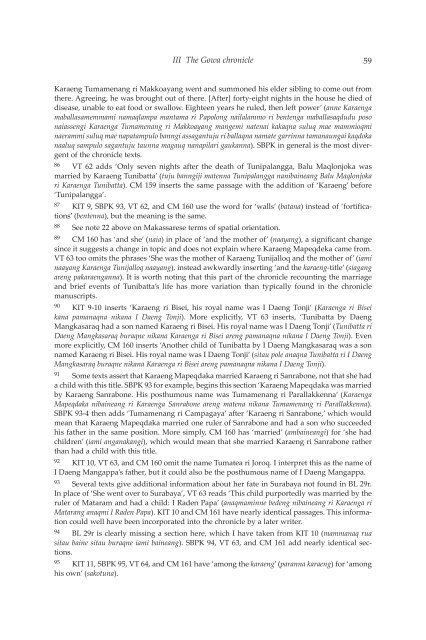A CHAIN OF KINGS - Books and Journals
A CHAIN OF KINGS - Books and Journals
A CHAIN OF KINGS - Books and Journals
You also want an ePaper? Increase the reach of your titles
YUMPU automatically turns print PDFs into web optimized ePapers that Google loves.
III The Gowa chronicle 59<br />
Karaeng Tumamenang ri Makkoayang went <strong>and</strong> summoned his elder sibling to come out from<br />
there. Agreeing, he was brought out of there. [After] forty-eight nights in the house he died of<br />
disease, unable to eat food or swallow. Eighteen years he ruled, then left power’ (anne Karaenga<br />
maballasamemmami namaqlampa mantama ri Papolong nailalammo ri bentenga maballasaqdudu poso<br />
naiassengi Karaenga Tumamenang ri Makkoayang mangemi natenai kakaqna suluq mae mammioqmi<br />
naerammi suluq mae napatampulo banngi assagantuju ri ballaqna namate garrinna tamanaungai kaqdoka<br />
naaluq sampulo sagantuju taunna magauq nanapilari gaukanna). SBPK in general is the most divergent<br />
of the chronicle texts.<br />
86 VT 62 adds ‘Only seven nights after the death of Tunipalangga, Balu Maqlonjoka was<br />
married by Karaeng Tunibatta’ (tuju banngiji matenna Tunipalangga nanibaineang Balu Maqlonjoka<br />
ri Karaenga Tunibatta). CM 159 inserts the same passage with the addition of ‘Karaeng’ before<br />
‘Tunipalangga’.<br />
87 KIT 9, SBPK 93, VT 62, <strong>and</strong> CM 160 use the word for ‘walls’ (batana) instead of ‘fortifications’<br />
(bentenna), but the meaning is the same.<br />
88 See note 22 above on Makassarese terms of spatial orientation.<br />
89 CM 160 has ‘<strong>and</strong> she’ (naia) in place of ‘<strong>and</strong> the mother of’ (naayang), a significant change<br />
since it suggests a change in topic <strong>and</strong> does not explain where Karaeng Mapeqdeka came from.<br />
VT 63 too omits the phrases ‘She was the mother of Karaeng Tunijalloq <strong>and</strong> the mother of’ (iami<br />
naayang Karaenga Tunijalloq naayang), instead awkwardly inserting ‘<strong>and</strong> the karaeng-title’ (siagang<br />
areng pakaraenganna). It is worth noting that this part of the chronicle recounting the marriage<br />
<strong>and</strong> brief events of Tunibatta’s life has more variation than typically found in the chronicle<br />
manuscripts.<br />
90 KIT 9-10 inserts ‘Karaeng ri Bisei, his royal name was I Daeng Tonji’ (Karaenga ri Bisei<br />
kana pamanaqna nikana I Daeng Tonji). More explicitly, VT 63 inserts, ‘Tunibatta by Daeng<br />
Mangkasaraq had a son named Karaeng ri Bisei. His royal name was I Daeng Tonji’ (Tunibatta ri<br />
Daeng Mangkasaraq buraqne nikana Karaenga ri Bisei areng pamanaqna nikana I Daeng Tonji). Even<br />
more explicitly, CM 160 inserts ‘Another child of Tunibatta by I Daeng Mangkasaraq was a son<br />
named Karaeng ri Bisei. His royal name was I Daeng Tonji’ (sitau pole anaqna Tunibatta ri I Daeng<br />
Mangkasaraq buraqne nikana Karaenga ri Bisei areng pamanaqna nikana I Daeng Tonji).<br />
91 Some texts assert that Karaeng Mapeqdaka married Karaeng ri Sanrabone, not that she had<br />
a child with this title. SBPK 93 for example, begins this section ‘Karaeng Mapeqdaka was married<br />
by Karaeng Sanrabone. His posthumous name was Tumamenang ri Parallakkenna’ (Karaenga<br />
Mapeqdaka nibaineang ri Karaenga Sanrabone areng matena nikana Tumamenang ri Parallakkenna).<br />
SBPK 93-4 then adds ‘Tumamenang ri Campagaya’ after ‘Karaeng ri Sanrabone,’ which would<br />
mean that Karaeng Mapeqdaka married one ruler of Sanrabone <strong>and</strong> had a son who succeeded<br />
his father in the same position. More simply, CM 160 has ‘married’ (ambaineangi) for ‘she had<br />
children’ (iami anganakangi), which would mean that she married Karaeng ri Sanrabone rather<br />
than had a child with this title.<br />
92 KIT 10, VT 63, <strong>and</strong> CM 160 omit the name Tumatea ri Joroq. I interpret this as the name of<br />
I Daeng Mangappa’s father, but it could also be the posthumous name of I Daeng Mangappa.<br />
93 Several texts give additional information about her fate in Surabaya not found in BL 29r.<br />
In place of ‘She went over to Surabaya’, VT 63 reads ‘This child purportedly was married by the<br />
ruler of Mataram <strong>and</strong> had a child: I Raden Papa’ (anaqmaminne bedeng nibaineang ri Karaenga ri<br />
Matarang anaqmi I Raden Papa). KIT 10 <strong>and</strong> CM 161 have nearly identical passages. This information<br />
could well have been incorporated into the chronicle by a later writer.<br />
94 BL 29r is clearly missing a section here, which I have taken from KIT 10 (mammanaq rua<br />
sitau baine sitau buraqne iami baineang). SBPK 94, VT 63, <strong>and</strong> CM 161 add nearly identical sections.<br />
95 KIT 11, SBPK 95, VT 64, <strong>and</strong> CM 161 have ‘among the karaeng’ (paranna karaeng) for ‘among<br />
his own’ (sakotuna).









![Am HaSefer [Volk des Buches] - Books and Journals](https://img.yumpu.com/20648352/1/174x260/am-hasefer-volk-des-buches-books-and-journals.jpg?quality=85)







